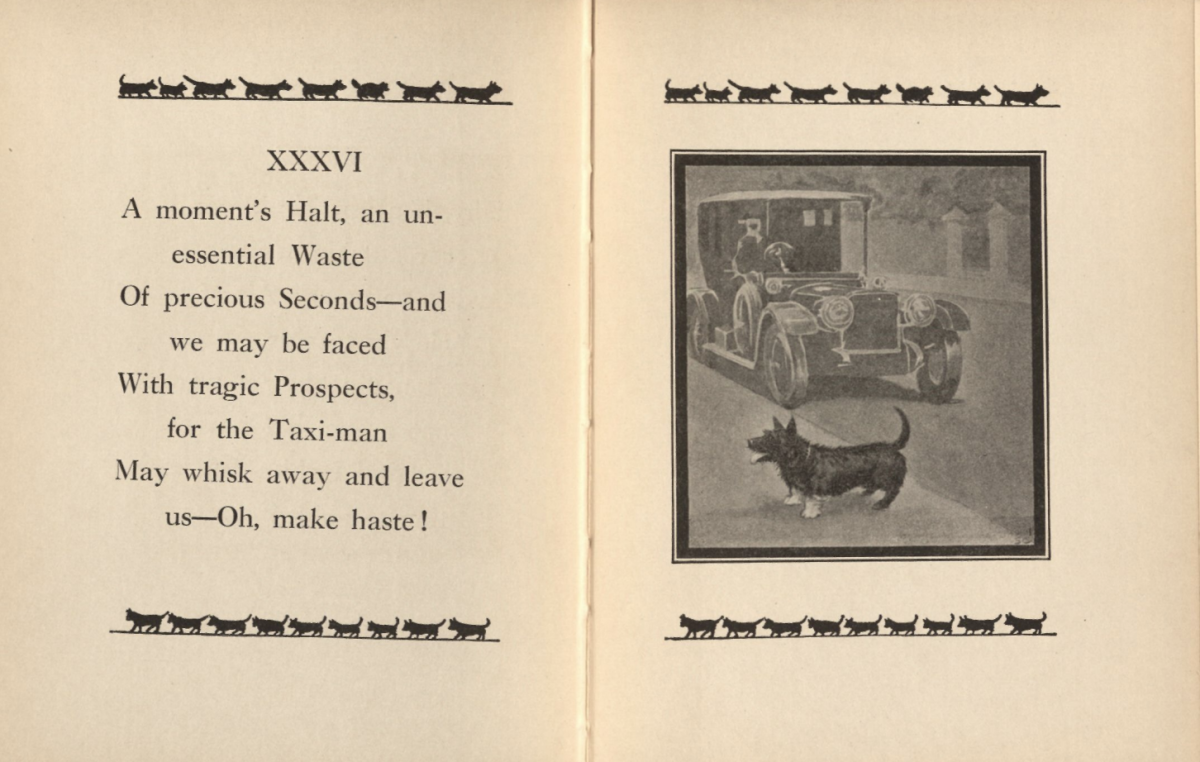Stanza thirty six of The Rubáiyát of a Scotch Terrier deters from the poem’s original meaning which we can see in the illustration and the diction. The illustration shows the reader the Scottish Terrier standing on a sidewalk with a taxicab in the background. Though we can’t see the dog’s owner, we can assume that is who he is waiting for. I gathered this from the dog’s stance and demeanor. He is panting and his tail is turned upward which gives him a joyful, alert and excited look. He is also facing away from the street, even though that is where the taxicab is. This makes me believe he is waiting for his owner who is out of the frame. (See image 1)
The illustration accompanying stanza thirty-six depicts solely the dog and taxicab. Though there is a slight outline of what looks like the driver of the taxi, the only noticeable depiction is the dog. This shows the author’s focus on the narrator. It’s also important to note that the owner is out of frame. Throughout the poem, the only human face we ever see is of a maid. Everytime one of the dog’s owners is illustrated, we only see parts of their body and clothing, but never their face. This lends me to believe Collins only wanted us to find meaning in the dog and his expressions.
The poem is about the dog’s desires, similar to how Khayyam’s Rubáiyát is about the narrator’s, Khayyam, desires. Because the dog is the narrator, we also only hear his thoughts. Due to this and the illustrations’ focus on the terrier, the reader only ever gets his perspective. This is interesting in comparing the two editions because it makes me wonder if Collins is satirizing Khayyam’s original Rubáiyát for only ever giving his perspective in it. However, the text doesn’t necessarily satirize this aspect, it simply gives us this one perspective. I do think it is important in analyzing this stanza however, because the original stanza that mirrors this one, discusses matters of other people. The language used in Fitzgerald’s edition that implies this is the line, “and the Caravan / Starts for the dawn of Nothing.” The term “caravan” can be defined in a historical context as a group of people traveling together across a desert. I thought this was interesting to note that the dog is the only living thing highlighted, when the original talks about a caravan of people. This in itself deters from the original message of the thirty-eighth stanza (See image 2).
Something else that confuses the meaning of Khayyam’s stanza is the text’s word choice. In these lines, the Scottish Terrier is worrying about the taxi driver missing them and picking up other people. He says, “Oh, make haste!” to his owner out of frame. Here, he is telling his owner to hurry or the taxi driver won’t see them and then find other people who want a cab instead. In Fitzgerald’s edition, stanza thirty-eight is also discussing hurrying for something. When I first compared these stanzas, I took this to mean they were both discussing matters of rushing and wanting something to happen quickly, thus making them similar. However, the stanzas that follow these greatly impact their meaning. Stanza thirty-seven in Fitzgerald’s edition completely changes the previous stanza (see image 3). He expresses, “how long, in infinite pursuit” saying that this rushing and waiting for the caravan is never ending. This speed through life of always waiting for the next thing is a never ending chase. It then reads, “Of This and That endeavour and dispute?” which dumbs down whatever is being chased. The word voice of, “This and That,” makes it more casual and seemingly unimportant. The following line expresses what he thinks should actually be done with our time as opposed to this constant pursuit: “Better be merry with the fruitful Grape.” Here he is saying, instead of continuously chasing something that isn’t significant, be happy with what you have now and enjoy your life in this moment as it is. However, the following stanza in Collins’ satire does not follow this same logic. In fact, it does the opposite. There is, again, an illustration of the terrier acting out what is written in the accompanying stanza. This illustration happens to be in the front of the taxicab, in his owner’s lap. The language describes the experience of being in the front of the car, relishing in the pleasures it gives him. The last line reads, “Of all Adventures, none with this compare!” Instead of following Khayyam’s thought process and deterring away from this making of haste, the terrier instead follows through with this pursuit and gains great rewards from it. Not only does he get pleasure from it, but he is also illuminating the idea that no other adventure is as gratifying as this one. Therefore praising and encouraging this infinite pursuit.



